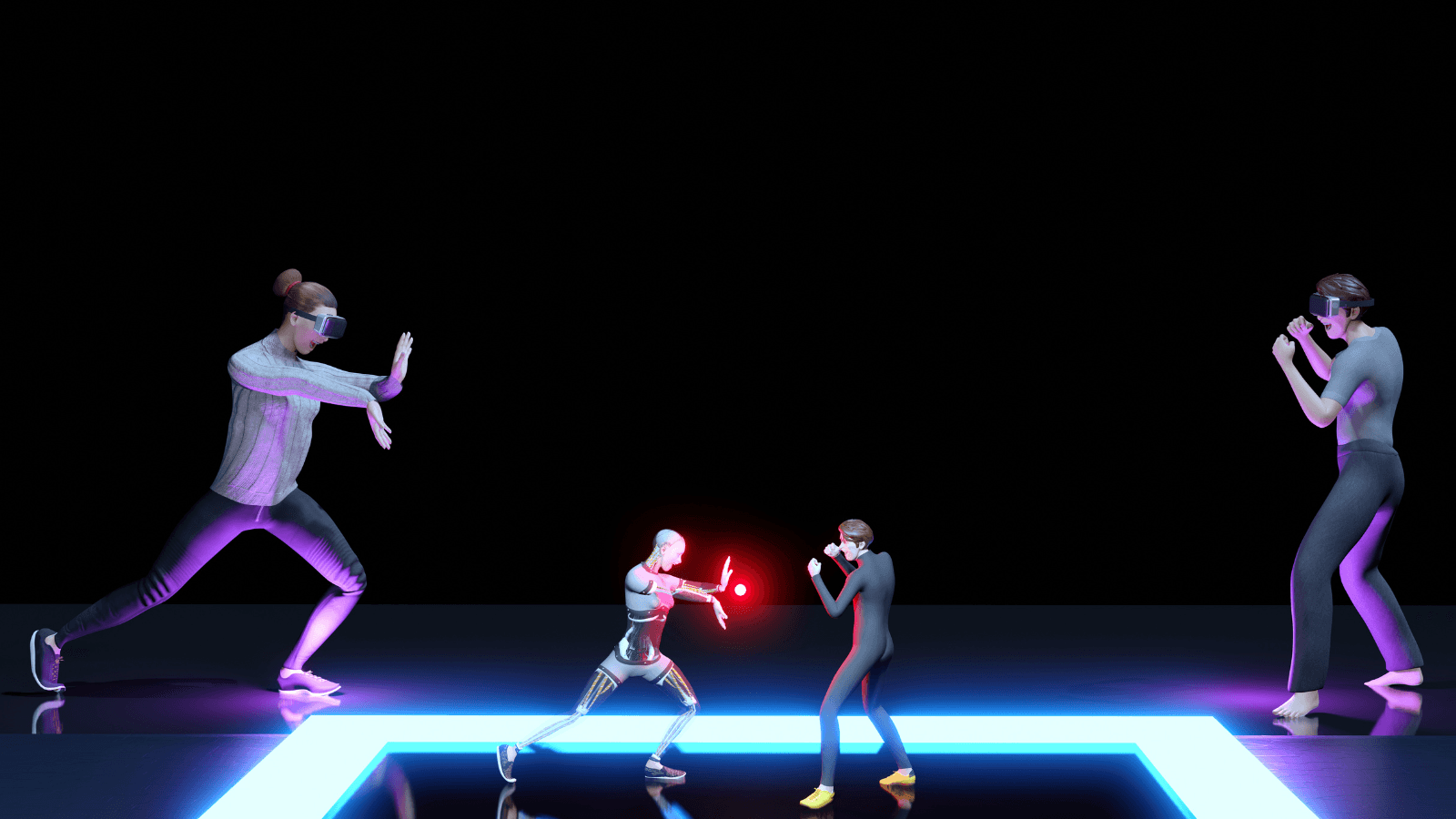Back to Blog
The Role of AI in Shaping the Metaverse
Oct 6, 2023
Callum Moates
Imagine a universe parallel to our own but made from bytes and pixels, where avatars roam landscapes, and the rules of physics can be bent. This digital landscape, ever-expanding and interconnected, is known as the metaverse or 3D internet. Driving engagement, creating high–fidelity and photorealistic environments, and creating interactive touchpoints in this virtual world depends highly on designers, developers, and agencies. However, continuing to scale up takes work, and artificial intelligence (AI) can help speed up the process, make it cost-effective, and eliminate the need for advanced skills to build the metaverse. AI is pivotal in improving user experience, creating intelligent avatars, and building a captivating virtual ecosystem through easy content creation. From understanding user behaviors to generating realistic virtual worlds, AI technologies are at the forefront, driving the 3D internet's capabilities beyond our imagination.
User experience
AI's integration into the metaverse has created a new era of user experiences, making them more personalized, adaptive, and predictive. Here's a closer look at how AI is elevating the metaverse experience:
AI-driven personalization: At the heart of an engaging metaverse experience is hyper-personalization. AI algorithms analyze vast user data, from basic profile information to intricate behavior patterns, user needs, and preferences, to tailor virtual environments to individual preferences and create highly contextual interactions. For instance, if a metaverse user with a history of purchasing casual wear in earthy tones enters a virtual storefront, the store's merchandising can be personalized through a virtual rack of clothing items that align with that individual’s style. This personalization makes the experience more relevant for a user and increases engagement.
Predictive algorithms: Predictive AI algorithms often anticipate user needs and actions before the user even realizes them. For example, if a user frequently visits virtual concerts in the 3D internet after work hours, the platform might suggest upcoming performances or reserve a virtual seat. These algorithms enhance user convenience and add an element of delight, making the metaverse experience more enjoyable.
Creating immersive experiences: AI's ability to understand and replicate real-world physics, emotions, and interactions is pivotal in making the metaverse genuinely immersive. Advanced AI models can simulate realistic weather, infrastructure, conversations, and emotional responses from virtual characters. Imagine walking into a virtual cafe where the AI-driven barista remembers your favorite drink or a virtual park where the environment changes based on your mood. Such deep immersion blurs the lines between virtual and reality, making users feel 'present' in the metaverse.
Inclusive user experience: The metaverse can ensure a user-friendly experience for all through inclusive user interfaces using AI technologies. For instance, speech recognition technologies can convert spoken words into text, while natural language processing aids in understanding user intent, helping those with hearing disabilities. Computer vision allows individuals with visual impairments to experience the images and videos in the metaverse. Translation tools can also breakdown language barriers, enabling users to use their preferred language.

Avatars and NPCs
In the metaverse, AI-driven avatars or non-player characters (NPCs) play a pivotal role in enhancing user immersion and interactivity. Powered by sophisticated AI algorithms, they aren't just static or scripted characters but dynamic avatars that can interact, respond, and evolve based on user interactions, making experiences personalized and unique.
Here's how AI breathes life into these virtual personas:
Creation of realistic avatars: Modern AI techniques, such as Generative Adversarial Networks (GANs), allow for the creation of visually realistic and unique avatars. Users can craft avatars resembling their real-world appearance or opt for fantastical representations. Beyond aesthetics, these avatars can have natural facial expressions and movements through AI. For instance, Epic Games' MetaHuman Creator is a cloud-streamed app allowing users to create realistic human faces and characters in minutes. This realism makes interactions more relatable in the 3D internet.
Natural language interaction: Leveraging Natural Language Processing (NLP) and Understanding (NLU) algorithms, NPCs can engage in meaningful conversations with users. Whether it's a virtual shopkeeper recommending products or a guide explaining the history of a virtual monument, these NPCs can answer questions, provide insights, and even indulge in casual chit-chat, much like a human would.
Decision-making and adaptability: Traditional NPCs in gaming environments were bound mainly by predefined scripts, leading to predictable behaviors. However, the integration of AI has revolutionized the way NPCs operate. NPCs can now evaluate and respond to situations based on context rather than just following a script. This dynamic adaptability ensures that each interaction in the metaverse feels unique and tailored to individual player actions. The 3D internet can embed sophisticated decision-making models or decision trees into NPCs to facilitate the assessment of various scenarios and potential outcomes. They prioritize actions based on a combination of predefined rules, historical data, and learned patterns from player interactions. This dynamic decision-making capability introduces a layer of realism and intricacy to the metaverse, elevating the overall experience.
Emotion recognition and response: NPCs with advanced AI models can detect user emotions based on their interactions, voice tone, or facial expressions. They can then respond empathetically, adjusting their behavior and dialogue to suit the user's emotional state. It enables NPCs to react suitably to various situations, be it comforting an upset player, rejoicing in a triumph, or showing interest in the player's actions. This human-like behavior of NPCs adds a layer of emotional intelligence to the metaverse, making interactions feel genuine and heartfelt.

Content creation
One of the significant challenges in expanding and enhancing the metaverse is the sheer volume of content required. Manual creation is time-consuming, skill-based, and often needs more scalability. AI-driven content generation addresses this bottleneck. By automating the creation of 3D digital assets, characters, environments, and even narratives without requiring technical skills, AI significantly reduces the time and resources needed to develop new virtual spaces and experiences. This acceleration is crucial for the rapid expansion and evolution of the 3D internet, ensuring it keeps pace with growing user expectations.
Here's how AI is revolutionizing content creation within the metaverse:
AI-generated virtual landscapes: Traditional digital designing methods to build sprawling city landscapes or lush green forests often require extensive manual effort. However, AI, especially generative adversarial networks (GANs), can automate this process. By feeding these networks vast amounts of data, they can generate intricate and realistic landscapes in a fraction of the time. NVIDIA's GauGAN is a tool that uses GANs to convert simple sketches or words into photorealistic landscapes.
Creation of 3D assets and models: AI can help turn 2D images into 3D assets or create entirely new objects. These life-like digital assets, like 3D chairs or tables, can be designed to have realistic textures. For instance, platforms like Alpha3D allow individuals to use prompts to create 3D digital assets that can be used within games, the metaverse, or as non-fungible tokens (NFTs).
Artistic expressions in the metaverse: AI is not just about replicating reality; it's also a tool for creative expression and to create digital art. Algorithms can be trained on various art styles, from Renaissance paintings to modern abstract art, and can generate unique artworks that blend or innovate upon these styles. Virtual art galleries in the 3D internet can showcase AI-generated masterpieces. For instance, one particular platform that helps create exciting digital art is Deep Dream by Google. This AI-driven platform transforms user-uploaded images into artworks resembling famous styles or psychedelic patterns.
Dynamic environments: Beyond static landscapes, AI can create dynamic environments that change based on user interactions or predefined conditions. Imagine a virtual forest that changes seasons based on real-world time or a city that evolves based on its virtual inhabitants' decisions. Such dynamic content ensures that the metaverse remains ever-fresh and engaging. Games like Minecraft have used procedural generation (a precursor to more advanced AI techniques) to create vast, unique landscapes whenever a new game starts or as users continue exploring the world deeper. Integrating advanced AI can take this to the next level.
Our upcoming product, Landvault Create, is poised to change the game for 3D content creation, making it 10x faster than manually and reducing building costs. This no-code AI assistant empowers users to transform their imaginative ideas into immersive 3D worlds by simply describing their concepts to generate 3D spaces and share them with a broader community.
The product uses a blend of procedural generation and AI, enabling users to craft a working prototype in minutes. Landvault Create supports popular game engines like Unity and Unreal through its SDK, streamlining the 3D environment creation process. Once the content is ready, users can swiftly publish it using Landvault Publish and monetize their creations with Landvault Monetize. Creators can also tap into an asset library enriched by procedural generation and share their content on our marketplace.

Conclusion
With its potential and immersive capabilities, the metaverse is emerging as the next frontier in digital interaction. Central to its evolution and expansion is the role of artificial intelligence (AI). AI enhances user experiences by personalizing virtual environments, predicting user needs, and creating inclusive digital experiences. Interactions in the 3D internet with avatars and non-player characters are becoming more human-like and natural, with realistic visual appearances, decision-making capabilities, and emotionally intelligent interactions. AI also drives high-quality content creation by automating the generation of 3D models, landscapes, and art. Tools like Landvault Create exemplify how AI is streamlining the creation of 3D content, making it faster and open to a broader audience. AI catalyzes the metaverse toward a future where digital and physical realities converge seamlessly, offering users unparalleled experiences and interactions.
Are you looking to build immersive experiences in the 3D world? We can help you build, scale, and monetize your creation in the metaverse by leveraging AI. Get in touch with us!
Oct 6, 2023
Callum Moates
Subscribe to our monthly newsletter
About Landvault
Landvault is building infrastructure to accelerate the metaverse economy, by building tools to create, deploy and monetize content. The company has helped over 200 clients enter the metaverse, including both Fortune 500 companies and government organizations like the Abu Dhabi government, Mastercard, L’Oreal, Red Bull, and Heineken. The company has raised a total of $40m over the past three years and continues to pioneer technological advancements.
